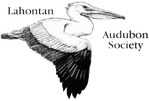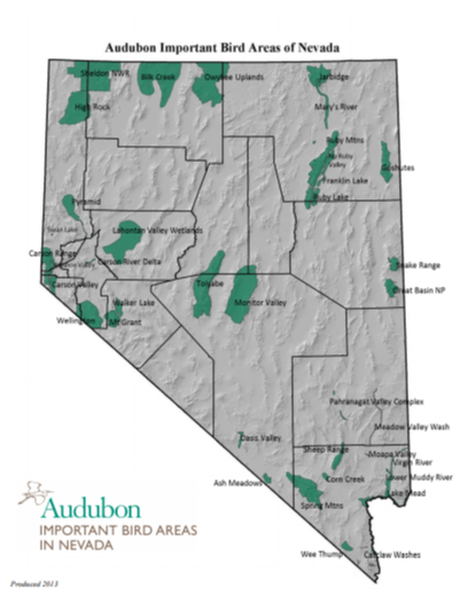NEVADA IMPORTANT BIRD AREAS (IBA)
The Important Bird Areas, or IBAs, Program is a world-wide effort to identify the most important places for bird populations and to focus conservation efforts. Within Nevada, there are 40 recognized IBAs, which are sites that provide essential breeding, migration, or wintering habitat for one or more species of birds. These sites contain threatened or endangered species, endemic (i.e., native and only found at a specific location) species representative of a habitat type, or a high concentration of species.
The NV IBA Program is focused on setting conservation priorities for the IBAs and developing partnerships for the ongoing protection and conservation of these sites. Habitat destruction and degradation contribute to a large percentage of avian species decline. The NV IBA program is focused on monitoring and conserving the unique habitats that make these sites Important Bird Areas. Through monitoring, project implementation, advocacy, and public outreach, conservation will have a greater chance at success. Nevada currently has 40 recognized IBAs. All of the Nevada IBAs have resource challenges and issues ranging from low to high risk to the IBA. Some of the most prevalent concerns include the following: Invasive plants Habitat degradation Development Fire management Water quantity & quality.
Learn more about the Nevada IBA program and view a list of Nevada IBAs here:
The NV IBA Program is focused on setting conservation priorities for the IBAs and developing partnerships for the ongoing protection and conservation of these sites. Habitat destruction and degradation contribute to a large percentage of avian species decline. The NV IBA program is focused on monitoring and conserving the unique habitats that make these sites Important Bird Areas. Through monitoring, project implementation, advocacy, and public outreach, conservation will have a greater chance at success. Nevada currently has 40 recognized IBAs. All of the Nevada IBAs have resource challenges and issues ranging from low to high risk to the IBA. Some of the most prevalent concerns include the following: Invasive plants Habitat degradation Development Fire management Water quantity & quality.
Learn more about the Nevada IBA program and view a list of Nevada IBAs here:
NEVADA IBA HISTORY & OVERVIEW
In 2001, the Nevada IBA Program began facilitating the nomination and recognition process to identify the key IBAs within Nevada. All Nevada IBAs have met at least one of the following criteria to be recognized as an IBA:
The currently recognized Nevada IBAs represent the broad spectrum of habitats and avian species found throughout the state, which demonstrates the state’s enormous floral and faunal diversity.
Core Program Values
Program Goals
In 2001, the Nevada IBA Program began facilitating the nomination and recognition process to identify the key IBAs within Nevada. All Nevada IBAs have met at least one of the following criteria to be recognized as an IBA:
- Sites important to Nevada species of concern as listed by the Nevada Partners in Flight Conservation Plan
- Sites harboring species restricted to unique/threatened habitat types
- Sites where significant numbers of birds congregate
- Sites supporting long-term avian research
- Sites providing outstanding educational opportunities
The currently recognized Nevada IBAs represent the broad spectrum of habitats and avian species found throughout the state, which demonstrates the state’s enormous floral and faunal diversity.
Core Program Values
- Protection and conservation of wildlife, particularly birds of conservation priority;
- Conserving healthy, functioning bird habitats;
- Promotion of habitat conservation and stewardship throughout Nevada while ensuring that public benefits, ecosystem services, and natural resource values are protected;
- Providing quality technical assistance and professional services to various stakeholders while utilizing the best available science;
- Stakeholder involvement and partnership development focusing on conservation goals and objectives.
Program Goals
- Goal 1. The unique and significant bird populations and their habitats within Nevada Important Bird Areas preserved, protected, and functional within healthy ecosystems.
- Goal 2. A network of Important Bird Areas under the stewardship of informed, engaged, and supportive community of stakeholders, partners, and others.
|
Conservation Wildlife and habitat conservation involves all aspects of project development and implementation. Typically, a habitat threats and/or issues assessment is conducted as part of the process for identifying projects and stakeholders. Since 2007, the NV IBA Program has undertaken a diversity of conservation, restoration, and enhancement projects with partners. Projects include Russian olive management, Cottonwood and shrub planting, habitat enhancement and restoration projects, and native seed collection. Public Outreach & Education By providing educational outreach, local communities will become engage and increase their local stewardship attitudes towards bird habitat conservation. LAS participates in outreach events including education about Nevada IBAs, pollinators, and hummingbirds, training local landowners on the proper methods for invasive plant management, training educators, and facilitators for the FlyingWild Bird Education Curriculum. Nevada Important Bird Areas Book In 2005, the Nevada IBA Program published Important Bird Areas of Nevada which serves as a guide to the IBAs, bird values, and other relevant information. Purchase on the LAS bookstore. |
list of nevada ibas
-
NORTHWESTERN, NV
-
NORTHEASTERN, NV
-
CENTRAL, NV
-
SOUTHERN, NV
<
>
- Sheldon NWR: Home to a suite of habitats for birds such as the Greater Sage-Grouse, Loggerhead Shrike, Sage Thrasher, and Brewer’s Sparrow
- Bilk Creek-Montana Mountains: Large Greater Sage-Grouse populations. Heavily monitored due to the 2012 Halloway fire that ravaged through 80% of this IBA
- Gridley Lake: High breeding Snowy Plover population, American Avocets and Killdeer are also known to breed here
- High Rock Canyon: Greater Sage-Grouse & cliff nesters such as raptors and swallows
- Pyramid Lake/Anaho Island: American White Pelicans breeding colony with 8,000-10,000 individuals on Anaho Island. This island also provides suitable breeding habitat for Double-crested cormorants, California gulls, Great blue herons, Black-crowned night herons, and occasionally Caspian terns.
- Swan Lake: Important habitat for birds year-round. Large numbers of Tundra Swans, shorebirds, and wading birds depend on this area for stopover habitat.
- Lower Truckee River: During the breeding season this area provides habitat for American White Pelican, Swainson’s hawk, bank swallow, western bluebird, yellow-breasted chat; several other species occur within the site during fall migration
- Lahontan Valley Wetlands: Provides habitat for upwards of 250,000 species of waterbirds during the breeding season and during migration. Long-billed Dowitcher, Western and Least sandpipers, American Avocet, Wilson's Phalarope, and Long-billed Curlew are a few notable species.
- Washoe Valley: Heron rookery & waterbird density
- Carson Range: High diversity of Sierra Nevada avian species, some do not occur anywhere else in the state or only occur in very few numbers: Pygmy Nuthatch, Band-tailed Pigeon, Mountain Quail, Pileated Woodpecker, White-headed Woodpecker, Black-backed Woodpecker, Red-breasted Sapsucker, and Winter Wren
- Carson Valley: The only colony of Tri-colored Blackbirds in Nevada is found in the Carson Valley The valley's wetlands are home to a diversity of waterbirds and an abundance of over-wintering raptors.
- Carson River Delta: Likely the last best remnant of a cottonwood-willow riparian forest in northwestern Nevada and an important migration corridor for neotropical species. Yellow-billed Cuckoos & Willow Flycatchers, White-faced Ibis, Swainson's Hawk, Western Bluebird, and Wilson's Warbler
- Jarbidge Mountains: High montane bird species such as the Blue Grouse and Red Crossbill, Cassin's Finch, Hermit and Swainson's Thrushes, Mountain Bluebird and Winter Wrens
- Mary’s River: Exceptional habitat for many species
- Goshute Mountains: Raptor species and migratory corridor
- North Ruby Valley: Highest density of breeding Long-billed Curlews and multiple Sage-Grouse leks.
- Ruby Mountains: Alpine habitat & alpine bird species such as all three rosy finch species, Himalayan Snowcocks and Hungarian Partridges.
- Owyhee Uplands: Home to approximately 110 Sage-Grouse leks and other songbirds such as Sage Thrashers and Brewer's Sparrows.
- Franklin Lake: High density of waterbirds such as Forster's, Caspian, and Black Terns
- Ruby Lake NWR: One of the most important areas for Great Basin wildlife with a wide variety of habitats including pristine marsh bordered by meadows, grasslands, shrub-steppe, and playa supporting over 225 species of birds and the largest breeding population of the canvasback west of the Mississippi River.
- Walker Lake: Habitats such as riparian, wetland, riverine, and desert lake supporting high density of waterbirds such as Western Snowy Plover, Common Loon, Western, Clarks, and Eared Grebes, Double-crested Cormorant, White-faced Ibis, Tundra Swan, Snow Goose, Gadwall, Redhead, Ruddy Duck, Northern Shoveler, and American White Pelican.
- Mount Grant: Exceptional habitat for upland and riparian birds. The landscape and habitat are topographically diverse and geologically complex, that have remained ungrazed for over 70 years.
- Wellington-Pine Grove Hills: High-quality habitat with a 5,000 foot-plus elevation range for sagebrush obligate and riparian species
- Toiyabe Range: Extensive Montane Shrub and pinyon-juniper communities are interspersed with mountain mahogany, with limited aspen and limber pine groves. Greater Sage-Grouse populations found throughout.
- Monitor Valley: High diversity of habitats within this range, isolated from human activity. Large Greater Sage- Grouse breeding population
- Snake Range: High quality habitat. Northern Goshawk, Cooper’s Hawk, Juniper Titmouse, Three-Toed Woodpecker, Black-throated Gray Warbler, MacGillivray’s Warbler, Pinyon Jay, Vesper Sparrow, and Sage Sparrow
- Great Basin National Park: Consisting of riparian habitat that includes sub-alpine meadows, aspen, cottonwood and dense-shrub supporting Rosy finch complex & alpine species
- Pahranagat Valley Complex: High density of migratory birds
- Meadow Valley Wash: Migratory corridor and Southwest Willow Flycatcher nesting area
- Oasis Valley: Migrating corridor between Great Basin and Mojave Deserts
- Sheep Range: Northernmost occurrence of Mexican Whip-poor-will
- Ash Meadows: Highest density of warblers and breeding habitat for Southwest Willow Flycatcher
- Moapa Valley: Breeding population of Southwest Willow Flycatcher. Ash-throated Flycatcher, Phainopepla, Yellow-billed Cuckoo, Western Bluebird, Yellow-breasted Chat, Blue Grosbeak, and Prairie Falcon
- Virgin River: Good habitat and important migration corridor. Yellow-billed Cuckoo, Southwestern Willow Flycatcher, Yuma Clapper Rail, and American White Pelican
- Spring Mountains: Highest density of breeding Flammulated Owls & migrating Rufous Hummingbirds
- Lake Mead: Migration & wintering habitat for waterbirds. Bald Eagle, Southwestern Willow Flycatcher, American White Pelican, American Avocet, Peregrine Falcon, Clark’s Grebe, Yellow-breasted Chat, and Lucy’s Warbler
- Wee Thump Joshua Tree Forest: Supreme habitat for cavity nesters
- Catclaw Washes: Highest Phainopepla densities. Ash-throated Flycatcher, Loggerhead Shrike, Western Bluebird, and Scott’s Oriole
- Lower Muddy River: Yuma Clapper Rail and SW Willow Flycatcher
- Corn Creek IBA: Largest density of LeConte's and Crissal Thrashers


